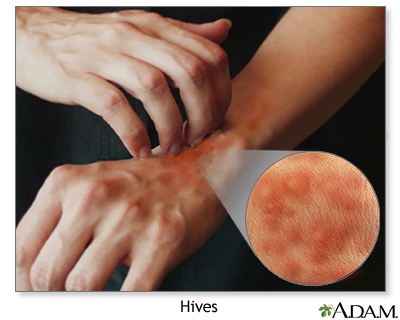Hives
Hives are raised, often itchy, red bumps (welts) on the surface of the skin. They can be an allergic reaction to food or medicine. They can also appear without cause.
What are hives? - Animation
Hives are allergic welts on the skin. I'm Dr. Alan Greene and let's talk about hives, how they happen, and what to do about them when you do get them. Hives are usually triggered by some kind of exposure. The most common ones are to medicines and to foods. But they can be to all kinds of different things. Even cold weather will cause hives in some people. Most of the time we don't figure out what the trigger actually was. But it's worth trying to figure out if you can. Sometimes the hives can be a sign of an allergic reaction that's serious. If you have hives and also have any difficulty breathing or have wheezing, consider that something when you need urgent medical attention. Otherwise with hives, usually you can calm down the swelling and the itching with an antihistamine. Typical over-the-counter antihistamine can work well. It's even stronger if you couple it with one of the over-the-counter antacids. An H1 blocker and an H2 blocker together such as Benadryl, or diphenhydramine, and cimetidine. Taking those together is more powerful than either one alone. You can talk to your pharmacist about how to combine an H1 and H2 blocker safely. Usually with that kind of treatment, the itching will subside fairly quickly and the whole thing will last for just a few hours unless the exposure is ongoing. Sometimes though, hives will become chronic. If you have hives that are lasting for a week or more, you certainly want to be in touch with your doctor to discuss what to do with longer lasting hives.
Causes
When you have an allergic reaction to a substance, your body releases histamine and other chemicals into the blood. This causes itching, swelling, and other symptoms. Hives are a common reaction. People with other allergies, such as hay fever, often get hives.
Angioedema is swelling of the deeper tissue that sometimes occurs with hives. Like hives, angioedema can occur on any part of the body. When it occurs around the mouth or throat, the symptoms can be severe, including airway blockage.
Angioedema
Angioedema is swelling that is similar to hives, but the swelling is under the skin instead of on the surface. Hives are often called welts. They a...

Many substances can trigger hives, including:
- Animal dander (especially cats)
- Insect bites
- Medicines
- Pollen
- Shellfish, fish, nuts, eggs, milk, and other foods
Hives may also develop as a result of:
- Emotional stress
- Extreme cold or sun exposure
- Excessive perspiration
- Illness, including lupus, other autoimmune diseases, and leukemia
Lupus
Systemic lupus erythematosus (SLE) is an autoimmune disease. In this disease, the immune system of the body mistakenly attacks healthy tissue. It c...
 ImageRead Article Now Book Mark Article
ImageRead Article Now Book Mark ArticleAutoimmune diseases
An autoimmune disorder occurs when the body's immune system attacks and destroys healthy body tissue by mistake. There are more than 80 autoimmune d...
 ImageRead Article Now Book Mark Article
ImageRead Article Now Book Mark ArticleLeukemia
Leukemia is a type of blood cancer that begins in the bone marrow. Bone marrow is the soft tissue in the center of the bones, where blood cells are ...
 ImageRead Article Now Book Mark Article
ImageRead Article Now Book Mark Article - Infections such as mononucleosis
Mononucleosis
Mononucleosis, or mono, is a viral infection that causes fever, sore throat, and swollen lymph glands, most often in the neck.
 ImageRead Article Now Book Mark Article
ImageRead Article Now Book Mark Article - Exercise
- Exposure to water
Often, the cause of hives is not known.
Symptoms
Symptoms of hives may include any of the following:
- Itching.
- Swelling of the surface of the skin into red- or skin-colored welts (called wheals) with clearly defined edges.
- Wheals may get bigger, spread, and join together to form larger areas of flat, raised skin.
- Wheals often change shape, disappear, and reappear within minutes or hours. It is unusual for a wheal to last more than 48 hours.
- Dermatographism, or skin writing, is a type of hives. It is caused by pressure on the skin and results in immediate hives in the area that has been pressed on or scratched.

Hives (urticaria) - close-up
Hives (urticaria) are raised, red, itchy welts. The majority of urticaria develop as a result of allergic reactions. Occasionally, they may be associated with autoimmune diseases, infections (parasitosis), drugs, malignancy, or other causes.
Exams and Tests
Your health care provider can tell if you have hives by looking at your skin.

Hives
Hives are raised red welts of various size on the surface of the skin, often itchy, which come and go. Also called uticaria, hives is usually part of an allergic reaction to drugs or food. The term dermatitis describes an inflammatory response of the skin, caused by contact with allergens or irritants, exposure to sunlight, or by poor circulation, even stress. AVOID SCRATCHING. Scratching the rash may spread the inflammation, lead to infection and even leave scars.
If you have a history of an allergy causing hives, for example, to strawberries, the diagnosis is even clearer.
Sometimes, a skin biopsy or blood tests are done to confirm that you had an allergic reaction, and to test for the substance that caused the allergic response. However, specific allergy testing is not useful in most cases of hives.
Skin biopsy
A skin lesion biopsy is when a small amount of skin is removed so it can be examined under a microscope. The skin is tested to look for skin conditi...

Treatment
Treatment may not be needed if the hives are mild. They may disappear on their own. To reduce itching and swelling:
- Do not take hot baths or showers.
- Do not wear tight-fitting clothing, which can irritate the area.
- Your provider may suggest that you take an antihistamine such as diphenhydramine (Benadryl) or cetirizine (Zyrtec). Follow your provider's instructions or the package instructions about how to take the medicine.
- Other oral prescription medicines may be needed, especially if the hives are chronic (long-lasting).
If your reaction is severe, especially if the swelling involves your throat, you may need an emergency shot of epinephrine (adrenaline) or steroids. Hives in the throat can block your airway, making it difficult to breathe.
Outlook (Prognosis)
Hives may be uncomfortable, but they are usually harmless and disappear on their own.
When the condition lasts longer than 6 weeks, it is called chronic hives. Usually no cause can be found. Most chronic hives resolve on their own in less than 1 year.
Possible Complications
Complications of hives may include:
- Anaphylaxis (a life-threatening, whole-body allergic reaction that causes breathing difficulty)
Anaphylaxis
Anaphylaxis is a life-threatening type of allergic reaction.
 ImageRead Article Now Book Mark Article
ImageRead Article Now Book Mark Article - Swelling in the throat can lead to life-threatening airway blockage
When to Contact a Medical Professional
Call 911 or the local emergency number if you have:
- Fainting
- Shortness of breath
- Tightness in your throat
- Tongue or face swelling
- Wheezing
Call your provider if the hives are severe, uncomfortable, and do not respond to self-care measures.
Prevention
To help prevent hives, avoid exposure to substances that give you allergic reactions.
Reviewed By
Ramin Fathi, MD, FAAD, Director, Phoenix Surgical Dermatology Group, Phoenix, AZ. Also reviewed by David C. Dugdale, MD, Medical Director, Brenda Conaway, Editorial Director, and the A.D.A.M. Editorial team.
Dinulos JGH. Urticaria, angioedema, and pruritus. In: Dinulos JGH, ed. Habif's Clinical Dermatology. 7th ed. Philadelphia, PA: Elsevier; 2021:chap 6.
James WD, Elston DM, Treat JR, Rosenbach MA, Neuhaus IM. Erythema and urticaria. In: James WD, Elston DM, Treat JR, Rosenbach MA, Neuhaus IM, eds. Andrews' Diseases of the Skin: Clinical Dermatology. 13th ed. Philadelphia, PA: Elsevier; 2020:chap 7.









 All rights reserved.
All rights reserved.